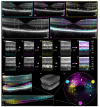Multi-directional optical coherence tomography for retinal imaging
- PMID: 29296488
- PMCID: PMC5745103
- DOI: 10.1364/BOE.8.005560
Multi-directional optical coherence tomography for retinal imaging
Abstract
We introduce multi-directional optical coherence tomography (OCT), a technique for investigation of the scattering properties of directionally reflective tissue samples. By combining the concepts of multi-channel and directional OCT, this approach enables simultaneous acquisition of multiple reflectivity depth-scans probing a mutual sample location from differing angular orientations. The application of multi-directional OCT in retinal imaging allows for in-depth investigations on the directional reflectivity of the retinal nerve fiber layer, Henle's fiber layer and the photoreceptor layer. Major ophthalmic diseases (such as glaucoma or age-related macular degeneration) have been reported to alter the directional reflectivity properties of these retinal layers. Hence, the concept of multi-directional OCT might help to gain improved understanding of pathology development and progression. As a first step, we demonstrate the capabilities of multi-directional OCT in the eyes of healthy human volunteers.
Keywords: (110.4500) Optical coherence tomography; (170.0170) Medical optics and biotechnology; (170.4470) Ophthalmology.
Conflict of interest statement
The authors declare that there are no conflicts of interest related to this article.
Figures










References
-
- Schmitt J. M., “Array detection for speckle reduction in optical coherence microscopy,” Phys. Med. Biol. 42(7), 1427–1439 (1997). - PubMed
-
- Iftimia N., Bouma B. E., Tearney G. J., “Speckle reduction in optical coherence tomography by “path length encoded” angular compounding,” J. Biomed. Opt. 8(2), 260–263 (2003). - PubMed
-
- Yang V. X. D., Munce N., Pekar J., Gordon M. L., Lo S., Marcon N. E., Wilson B. C., Vitkin I. A., “Micromachined array tip for multifocus fiber-based optical coherence tomography,” Opt. Lett. 29(15), 1754–1756 (2004). - PubMed
Grants and funding
LinkOut - more resources
Full Text Sources
Other Literature Sources
Research Materials
